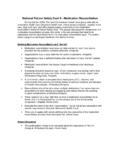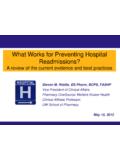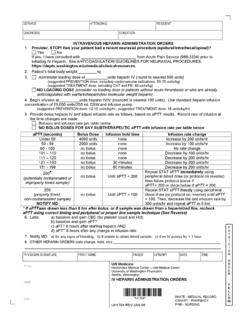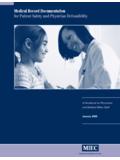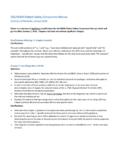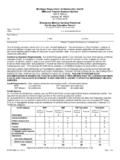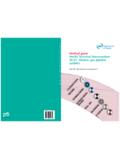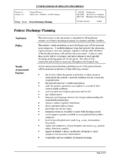Transcription of The Impact of Abbreviations on Patient Safety
1 576 September 2007 Volume 33 Number 9 The Joint Commission Journal on Quality and Patient SafetyWithin the past decade medication errors haveemerged as a significant Patient Safety concernand have been shown to account for up to7,000 deaths per intervention aimed at reduc-ing the incidence of medication errors is improving writ-ten or electronic communications, particularly in patientmedical charts. In 2004 The Joint Commission intro-duced the Do Not Use list of abbreviations2as part ofthe requirements for meeting National Patient Safety Goal2, which addresses the effectiveness of communicationamong caregivers. Goal 2B requires health care organiza-tions to maintain a standardized list of Abbreviations ,acronyms, and symbols that are not to be addition to the Do Not Use list, the organizationis required to develop additional restrictions pertaining tothe use of Abbreviations .
2 In May 2005, the Joint Commis-sion s required Do Not Use list was reaffirmed4,5 (Table 1,page 578). Despite the list s availability since 2004, non-compliance remains a frequent finding (23%) during JointCommission surveys. Furthermore, annual Joint Commis-sion survey results have shown a decreasing trend ( to ) in compliance in hospitals from 2004 failures are the most common rootcause of sentinel events, accounting for more than 60% ofevents from 2002 through , communica-tion lapses are the result of using Abbreviations when con-veying medication orders. Staff responsible for reading,interpretation, and processing medication orders may notrecognize or may misconstrue an abbreviation, resulting inthe alteration of the intended meaning. An example com-monly reported is the misinterpretation of the letter U intended to represent the word units being frequentlyinterpreted as a 0 (that is, 10U is misread as 100 units).
3 If not caught, this error would likely result in theadministration of an inappropriate dose, potentially harm-ing our knowledge, however, the deleteriouseffect of using Abbreviations has not been previously quan-tified. The purpose of this study was to provide furtherevidence about Patient Safety risks that result from United States Pharmacopeia (USP) MEDMARX program is a national medication error reporting programthat allows subscribing facilities (hospitals and their relat-ed health systems) to report and track medication errors ina standardized format. MEDMARX uses the NationalCoordinating Council for Medication Error Reportingand Prevention (NCC MERP) Index for CategorizingMedication Errors to measure error outcomes, in whichCategories E through I indicate Patient ,10 The valid-ity of this instrument was recently char-acteristics and Impact of abbreviation use are summarizedand analyzed in this article on the basis of error recordssubmitted to MEDMARX between 2004 and error records submitted during the study period thatcontained Abbreviation as one of the causes of error wereThe Impact of Abbreviations on Patient SafetyUSP Medication Safety ForumLuigi Brunetti, John P.
4 Santell, , W. Hicks, , Editor: James G. Stevenson, , College of Pharmacy,University of Michigan, and University of Michigan Hospitals. This depart-ment features medication error issues based on data collected by theUnited States Pharmacopeia (USP). Copyright 2007 Joint Commission on Accreditation of Healthcare Organizations577 September 2007 Volume 33 Number 9 The Joint Commission Journal on Quality and Patient Safetyidentified and exported to a worksheet format. Machinereading of the records was done using keywords (from the Do Not Use list and previous USP publications12,13) infilter mode. Figure 1 (above) outlines the methodology ofthe study. The researchers also read any record that couldnot be machine read, looking for evidence of any abbrevi-ation that was involved in the errors. Any record thatcould not be associated with a particular abbreviation wasdiscarded from the sample.
5 Each record that remained in the final data set was eval-uated, using the Index for Categorizing MedicationErrors, for the node (or phase in the medication useprocess), the level of staff associated with making the error,and the type of error that resulted. When records wereassessed for the types of error involved in the event, thenumber of times a type of error was selected rather thanthe number of records containing that error type was usedfor calculations because each error record may have con-tained more than one type of error. Errors were also exam-ined by discipline (medicine, pharmacy, or nursing)involved in the event. All data were analyzed usingdescriptive SAMPLEFrom 2004 through 2006 a total of 643,151 medicationerrors were reported to the MEDMARX program from682 facilities. Of these errors, 29,974 ( ) were attrib-utable to abbreviation use.
6 Through machine and staffreading, records were grouped into themes or (n= 11,821) of the abbreviationerrors were excluded due to lack of information providedfrom the reporter in the error description to allow classifi-cation of the abbreviation. The final sample size consistedof 18,153 medication error reports. These reports weredistributed into the appropriate recurring themes, here-after referred to as abbreviation groups. The primary variables measured included (1) volume orFigure study s methodology is * Data pool based on available data. Node for category A reports not recorded since these events were not errors, but had the potential to cause error. Based on reporter selection; each abbreviation may have resulted in more than one error type. Copyright 2007 Joint Commission on Accreditation of Healthcare OrganizationsSeptember 2007 Volume 33 Number 9 The Joint Commission Journal on Quality and Patient Safetydistribution of reports in each abbreviation group, (2) theerror outcome using the NCC MERP Index, (3) node whereerror originated, (4) staff involved, and (5) type of error.
7 ABBREVIATIONGROUPSThe frequency of abbreviation groups involved in med-ication errors is summarized in Table 2 (page 579). Themost common abbreviation resulting in a medication errorwas the use of QD in place of once daily, accountingfor of all errors, followed by U for units ( ), cc for mL ( ), MSO4 or MS for morphinesulfate ( ), and decimal errors ( ). Drug nameabbreviations other than MSO4 (morphine sulfate) orMgSO4 (magnesium sulfate) were represented by theabbreviation group drug name. Abbreviations for drugnames using the stem (for example, nitro = nitroglycerin)were placed in the abbreviation group stem. ERROROUTCOMEThe majority of errors were associated with an NCCMERP categorization of A, B, or C (28%, , , respectively). Using the sample size available forevaluation as the denominator (n= 18,153); oferrors resulted in Patient harm (NCC MERP Categories Ethrough I).
8 The most common Abbreviations resulting inpatient harm are summarized in Table 3 (page 580).NODE WHEREERRORORIGINATEDE ighty-one percent of the errors occurred at the pre-scribing node of the medication process, while errorsoccurring at the transcribing and dispensing nodesoccurred with much less frequency, representing only 14%and of errors, respectively. Administration, monitor-ing, and procurement combined represented less than 2%of errors. STAFFINVOLVEDA bbreviation errors originated more often from medical staff ( ) in comparison to nursing ( ),pharmacy ( ), other health care providers ( ), and non health care providers ( ). As shown in Table4 (page 581), the Abbreviations with the greatest incidencediffered among staff. For example, the top abbreviationerrors among medical staff were sc ( ; 319/353occurrences), HS ( ; 424/483), and cc ( ;1705/2036), while the top Abbreviations among nursingstaff were IU ( ; 6/13), stem drug names,( ; 5/17 incidents), and TID ( ; 20/72).
9 Theuse of BID ( ; 35/165), g ( ; 14/67occurrences), and d/c ( ; 25/123) were identifiedas the abbreviation errors with the greatest incidence with-in the pharmacy staff. 578 Table 1. The Joint Commission s Do Not Use Abbreviation List*Do Not UsePotential ProblemUse InsteadU (unit)Mistaken for 0 (zero), theWrite unit number 4 (four), or cc IU (International Unit)Mistaken for IV (intravenous)Write International Unit or the number 10 (ten) , QD, , qd (daily)Mistaken for each other;Write daily , QOD, , qodperiod after the Q mistaken forWrite every other day (every other day) I and the O mistaken for I Trailing zero ( mg) Decimal point is missedWrite X mg Lack of leading zero (.X mg)Write mg MSCan mean morphine sulfateWrite morphine sulfate MSO4 and MgSO4or magnesium sulfate; Write magnesium sulfate confused for one another* Applies to all orders and all medication-related documentation that is handwritten (including free-text computer entry) or on preprinted forms.
10 Exception: A trailing zero may be used only where required to demonstrate the level of precision of the value being reported, such as for labo-ratory results, imaging studies that report size of lesions, or catheter/tube sizes. It may not be used in medication orders or other medication-relat-ed 2007 Joint Commission on Accreditation of Healthcare Organizations579 September 2007 Volume 33 Number 9 The Joint Commission Journal on Quality and Patient SafetyTYPES OFERRORE rrors involving Abbreviations were also examined bythe types of error associated with the event. A total of19,048 error type selections were reported in 18,153records and sorted to their respective abbreviation , the three most common types of error resultingfrom abbreviation use were prescribing ( ), improp-er dose/quantity ( ), and incorrectly prepared med-ication ( ).
